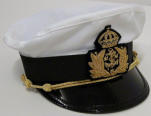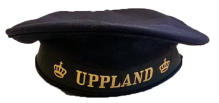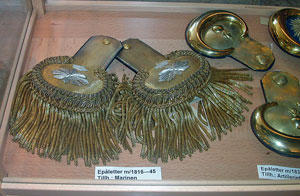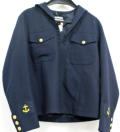

Copyright © Hans Högman 2019-01-25


Uniforms - Nomenclature
The terms below are listed in alphabetical order by
their English names. The Swedish corresponding
names are listed within brackets.
Aiguillette (Ägiljett)
An aiguillette, also spelled aguillette, aiglet or aglet,
is a cord with metal tips or lace tags, or the
decorative tip itself. In modern usage, an
"aiguillette" is an ornamental braided cord with
decorative metal tips worn on uniforms or as part
of other costumes such as academic dress,[1]
where it will denote an
honor. This usage of
"aiguillette" derives
from lacing used to
fasten plate armor
together. As such, a
knot or loop
arrangement was used
which sometimes
hung from the
shoulder.
Karlsborgs fästningsmuseum. Photo Hans Högman
2006.
Battle dress uniform (Fältuniform)
A battledress is a type of uniform used as combat
uniforms, as opposed to dress uniforms or formal
uniform worn at parades and functions. Also known
as combat uniform and is the utility uniform worn
in garrison and in combat zones.
Bicorne
The bicorne or bicorn (two-cornered/horned or
twihorn) is a historical form of hat widely adopted
in the 1790s as an item of uniform by European
and American military and naval officers. It is now
most readily associated with Napoléon Bonaparte
but in practice most generals and staff officers of
the Napoleonic period wore bicornes, and it
survived as a widely worn full-dress headdress until
at least 1914.
Blue Flap Collar (Blåkrage)
The naval blue flap collar was worn
with the sailor’s jumper. The blue
flap collar is perhaps the most
recognizable item of the sailor suit.
Broadcloth (Kläde)
Broadcloth is a dense, plain woven cloth,
historically made of wool. The defining
characteristic of Broadcloth is not its finished width,
but the fact that it was woven much wider (typically
50 - 75% wider than its finished width) and then
heavily milled (traditionally the cloth was worked by
heavy wooden trip hammers in hot soapy water) in
order to shrink it to the required width.
Burlap (Buldan)
Burlap (Hessian fabric) is a woven fabric usually
made from skin of the jute plant or sisal fibers, to
make rope, nets, and similar products. Gunny is
similar in texture and construction.
Bussarong
Sailor’s jumper.
Båtsman (Rotebåtsman /
indelt båtsman)
The Swedish navy seamen were called "båtsmän"
until 1901 and served aboard the Navy ships. They
manned the artillery aboard and also had sailing
duties. Between 1682 and 1901 they were provided
through a system called the Allotment System (Swe:
Indelningsverket). Another name was
“Kronobåtsman”. You can also see the terms
rotebåtsman and indelt båtsman.
It is båtsman in singular and båtsmän in plural. The
term literally means “boat man”.
-C-
Cabin Boys Corps (Skeppsgossekåren)
In 1685 the Cabin Boys Corps (Skeppsgossekår) was
established at the Karlskrona naval base. From1732
the boys had to be at least 10 years old to be
admitted. In 1776 the age of admission was
lowered to 8.The cabin boys were fully trained at
the age of 18. They then became seamen (båtsmän)
through a ceremony called karlskrivningen
(karlvuxen). The cabin boys were future petty
officers in the navy.
Cadet (Kadett)
A cadet is a trainee. The term is frequently used to
refer to those training to become an officer in the
military. Its meaning may vary between countries.
Cannoneer (Marinjär / Kanonjär)
The title of a marine soldier being gun crew at a sea
fortress.
Chevron
A chevron (also spelled cheveron, especially in older
documents) is a V-shaped mark, often inverted. The
word is usually used in reference to a kind of fret in
architecture, or to a badge or insignia used in
military or police uniforms to indicate rank or
length of service, or in heraldry and the designs of
flags (see flag terminology).
Dress Uniform (Livmundering)
The “livmundering” was the service dress for use in
the field, i.e. battledress, dress uniform. However,
in the 17th and 18th century the service dress was
also the dress uniform (then equipped with special
uniform details such as plumes etc)
Enrolleringsbåtsmän
There were a number of enlisted
“båtsmän”/seamen based at the naval station at
Karlskrona called Enrolleringskarl or
Enrolleringsbåtsman. They were a kind of “elite”
seamen and together with the crew drafted from
the merchant navy (kofferdimatroser) they
performed the more advanced sailing duties on
board the ships. This type of navy seamen were
foremost used in the 1700s.
Epaulet (Epålett)
Epaulet is a type of ornamental shoulder piece or
decoration used as insignia of rank by armed forces
and other organizations. In several European
armies, epaulets are also worn by all ranks of elite
or ceremonial units when on parade. Epaulets are
fastened to the shoulder by a shoulder strap, a
small strap parallel to the shoulder seam, and the
button near the collar, or by laces on the underside
of the epaulet passing through holes in the
shoulder of the coat.
The placement of the epaulet, its color and the
length and diameter of its bullion fringe are used to
signify the wearer's rank.Epaulets first appeared on
Swedish uniforms in the second half of the 18th
century. The epaulet was officially incorporated into
Swedish uniform regulations in 1792, although
foreign recruited regiments had had them earlier.
Senior officers were to wear golden crowns to
distinguish their rank from lower ranking officers
who wore golden stars.
Epaulets were discontinued on the field uniform in
the mid-19th century, switching to rank insignia on
the collar of the uniform jacket. Epaulets were
discontinued when they were removed from the
general issue dress uniform in the 1930s. They are,
however, still worn by
the Royal Lifeguards and
by military bands when
in ceremonial full dress
Karlsborgs
fästningsmuseum. Photo
Hans Högman 2006.
Flag Officer (Flaggman)
A flag officer is a commissioned officer in a nation's
armed forces senior enough to be entitled to fly a
flag to mark the position from which the officer
exercises command. In many countries, a flag
officer is a senior officer of the navy, specifically
those who hold any of the admiral ranks; the term
may or may not include the rank of commodore.
Flanell
Flannel is a soft woven fabric, of various fineness.
Flannel was originally made from carded wool or
worsted yarn
Full Dress uniform (Trupparaddräkt)
Full dress uniform, sometimes called dress uniform,
is the most formal type of military uniform,
reserved for parades, ceremonies, official
receptions, and other special occasions of the most
formal level, including private ones such as
marriages and funerals. Full dress uniforms often
goes with order insignias and full size medals.
Full Mess Dress (Stor mässdräkt)
The Swedish full mess dress (known as stor
mässdräkt) is formal wear to be worn on occasions
when a civilian would wear white tie or a tailcoat.
The Swedish Army code for full mess dress is m/86,
the navy is m/1878, and the air force m/1938. The
numbers represent the year in which the style was
introduced. The full mess dress is the equivalent of
Dress Uniform.
Lesser Mess Dress (Liten Mässdräkt)
The "lesser" (liten) and "full" (stor) mess dress are
two uniforms of the Swedish Armed Forces uniform
subgroup of "social uniforms" (sällskapsuniformer).
Aside from mess dress, this group also includes
"formal wear" and "society wear". The Swedish
lesser mess dress is the equivalent of the civilian
black tie. It is the same as the British mess undress
or the American mess dress blues.
Gaiter (Stiblett/Damask)
Gaiters are garments worn over the shoe and lower
pants leg, and used primarily as personal protective
equipment; similar garments used primarily for
display are spats. The Swedish army was using
knee-high gaiters in the end of the 1700s. The
gaiters were buttoned up on the outer side of the
gaiters
-H-
Kapott
Greatcoat with sleeves and hood used by the
Swedish Sea Artillery.
Kardong
Brass or leather straps used as adornment on
military hats
Kofferdimatros / Kofferdibåtsman /
Kofferdikarl
They were professional seamen drafted from the
mercantile navy. They were in charge of all the work
that had to do with the actual sailing (with the help
of the "båtsmän"). The “kofferdimatroser” were
part-time enlisted seamen and had a personal
contract with the Navy. They were paid in cash and
had to serve in the Navy for 6 month per year. Rest
of the year they served on mercantile ships.
Kollett (Kolett)
The kollett was a type of jacket shorter than the
coat, had a standing collar but no tails. The kollett
was used during summers and drill exercises. The
corresponding garment in English is probably
coatee. A coatee was a type of short tight fitting
uniform coat or jacket.
Kommisskläde
Mellanting mellan kommiss och kläde som används
i bl.a. mössor.
-L-

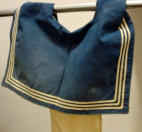
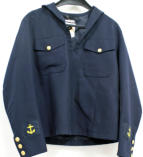
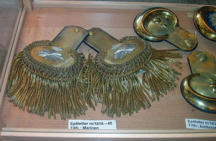
Uniforms of the Swedish
Navy - Nomenclature
Lampasses (Revärer)
Lampasse(s) or trouser stripes are in a large number
of national armed forces trouser stripes. In German
speaking countries as General Staff–qualified
officers, their uniform featured these distinctive
double-wide lampasses. Because of the similar
spelling, it should not be mixed up with the Lampas
(French: Lampas).) which is of different meaning.
Linen Weave (Lärft)
Plain weave (also called tabby weave, linen weave or
taffeta weave) is the most basic of three
fundamental types of textile weaves. In plain weave,
the warp and weft are aligned so they form a simple
criss-cross pattern. Each weft thread crosses the
warp threads by going over one, then under the
next, and so on. The next weft thread goes under the
warp threads that its neighbor went over, and vice
versa.
Mess Jacket (Mässjacka)
The mess jacket is a type of formal
jacket that ends at the waist. Today,
the jacket continues to be used as part
of military mess dress. It was adopted
as part of mess dress, the military
formal evening wear equivalent to
civilian white tie and black tie.
Nationella dräkten
In 1778 King Gustav III introduced the so-called
national dress uniform known as the “Svenska
dräkten” or “nationell drakten”.
A version of this uniform was also introduced in the
navy, a dark blue uniform with the designation
m/1778.
The national dress uniform was made both in
military versions as well as civilian versions. The civilian
dress was used by the Royal Court, cabinet
ministers, civil servants etc.
With the national dress uniform the Swedish Navy
and the Army Fleet received a uniform that in large
differed very much from the international naval
fashion of officers at the time. It was used in the
military between 1778 and 1802.
Navy Cap / Sailor Cap (Rundmössa)
Navy cap (round cap) or sailor cap is a round, flat
visorless hat worn by sailors in many of the world's
navies. A tally, an inscribed black silk ribbon, is tied
around the base which usually bears the name of a
ship or a navy. The tally on a sailor's cap is a ribbon
usually bearing the name of a ship or some other
establishment to which he belongs.
-P-
Peaked Cap (Skärmmössa)
A peaked cap/visor cap is a form of
headgear worn by the armed
forces of many nations, as well as
many uniformed civilian
organizations such as law
enforcement agencies and fire departments. It
derives its name from its short visor (American
English, known as a peak in British English), which
was historically made of polished leather but
increasingly is made of a synthetic substitute
Pea Coat (Stortröja)
A pea coat (or pea jacket) is an outer coat, generally
of a navy-colored heavy wool, originally worn by
sailors of European and later American navies. Pea
coats are characterized by short length, broad lapels,
double-breasted fronts, often large wooden, metal
or plastic buttons, and vertical or slash pockets.
A bridge coat is a pea coat that extends to the thighs,
and is a uniform exclusively for officers and chief
petty officers.
Pelerin
Sleeveless coat, cloak.
Pigtail (Stångpiska)
In the context of hairstyles, the usage of the term
pigtail (or twintail or twin tail) shows considerable
variation. The term may refer to a single braid, but
when used in the plural it often refers to twin
bunches of hair on opposite sides of the head. From
the later 17th century through the 19th century, the
term came to be applied to any braided ("plaited", in
British parlance) hairstyle. The British army also
adopted a single pigtail or "queue" as its standard
dress for long hair. The Swedish Army soldiers used
pigtail in the 1700s with black braids.
Piping (Passpoal)
In sewing, piping is a type of trim or embellishment
consisting of a strip of folded fabric so as to form a
"pipe" inserted into a seam to define the edges or
style lines of a garment or other textile object.
Usually the fabric strip is cut on the bias. It may be
made from either self-fabric (the same fabric as the
object to be ornamented) or contrasting fabric, or of
leather.
Rank Insignias (Gradbeteckningar)
Rank insignias are worn on military uniforms to
denote the wearers rank
Round Jacket (Rundtröja)
Colloquially known as 'the jacket', this was originally
a more practical 'working' version of the full dress
coat that was improvised by officers cutting off the
tails of a spare undress coat.
Jacka som ursprungligen ingick i släpuniformen -
enklare mässjacka. Från 1875 även vit och förekom
från 1860 med blåkragad skjorta för skeppsgossar.
Råbandshalsduk
Black scarf used by the navy tied with a reef knot.
Sailor Cap (Rundmössa)
Navy cap (round cap) or
sailor cap is a round, flat
visorless hat worn by
sailors in many of the
world's navies.
A tally, an inscribed black silk ribbon, is tied around
the base which usually bears the name of a ship or a
navy. The tally on a sailor's cap is a ribbon usually
bearing the name of a ship or some other
establishment to which he belongs.
Serge (Boj)
Serge (Swedish: Boj) is a type of twill fabric that has
diagonal lines or ridges on both sides, made with a
two-up, two-down weave. The worsted variety is
used in making military uniforms, suits, great coats
and trench coats.
Service Dress Uniform (Daglig dräkt)
Service dress uniform is a style of military uniform
that is the equivalent of a business suit, i.e. dress
clothes - not the very most formal attire yet not
casual attire either, but rather pertaining to the
traditional Western dress code of informal attire.
Shoulder mark (Axelträns)
A shoulder mark, also called an epaulette, shoulder
board, rank slide, or slip-on , is a flat cloth sleeve
worn on the shoulder strap of a uniform. It may bear
rank or other insignia.
Shoulder Straps (Axelklaff)
Many military uniform shirts, jackets, tunics, or
greatcoats feature shoulder straps. They were
originally designed to keep back packs, ammunition
pouches or bayonets from slipping off the shoulder.
They often display badges of rank, shoulder marks,
regimental insignia or epaulets.The Carolean
uniforms had shoulder straps affixed on the
shoulders. Musketeers had two straps, one on each
shoulder; one to keep the bandoleer to the cartridge
pouch in place, the other shoulder strap was to keep
the musket in place on the shoulder. The pikemen
had only one shoulder strap on the right shoulder to
keep the sword belt in place.
Side cap (Båtmössa)
A side cap is a foldable military cap
with straight sides and a creased or
hollow crown sloping to the back
where it is parted. It is known as a
garrison cap or flight cap in the
United States, wedge cap in Canada)
or field service cap in the United Kingdom. In
Sweden this style of headdress is known as a
"båtmössa" (lit. "boat cap"). It is mainly used by the
Swedish Police, and also by Navy and Air Force
personnel.
Standing Collar (Ståndkrage)
Standing or stand-up, fitting up around the neck and
not lying on the shoulders. Collars may also be
stiffened, traditionally with starch; A stiff standing
collar for men's formal wear, differentiated from
other tall styles by the lack of tabs at the front.
Stockings (Knästrumpor)
The stockings (knee socks) reached above the knees
and usually made of knitted of wool. They were kept
in place by straps and brass clasps. It was common
to wear two pair of stockings on top of each other.
The stockings were normally yellow but there were
variations: For example the Närke-Värmlands and
Jönköping regiments wore red stockings and the
Västerbotten regiment wore white stockings. Mid-
1690s a special type of protective stocking was
introduced to be worn on top of the ordinary
stockings. These protective stockings was made of
broadcloth or frieze (vadmal) for winter usage and
linen for summer usage. These outer stockings were
predecessor to the gaithers (spats). At the end of the
1690s a new regulation stated that the stockings was
to be in the same color as respective regiment’s
color of the lining
-T-
Tailcoat (Frack)
A tailcoat is a coat with the front of the skirt cut
away, so as to leave only the rear section of the skirt,
known as the tails. The historical reason coats were
cut this way was to make it easier for the wearer to
ride a horse, but over the years tailcoats of varying
types have evolved into forms of formal dress for
both day and evening wear.
Tails (Skört)
A tailcoat is a coat with the front of the skirt cut
away, so as to leave only the rear section of the skirt,
known as the tails. The historical reason coats were
cut this way was to make it easier for the wearer to
ride a horse, but over the years tailcoats of varying
types have evolved into forms of formal dress for
both day and evening wear
Tally (Mössband)
A tally is an inscribed black silk ribbon, tied around
the base of a sailor’s cap which usually bears the
name of a navy ship. The tally on a sailor's cap is a
ribbon usually bearing the name of a ship or some
other establishment to which he belongs.
Trimming (Bräm)
Trim or trimming in clothing is applied ornament,
such as gimp, passementerie, ribbon, ruffles, or, as a
verb, to apply such ornament.
Trousers/Breeches (Byxor/knäbyxor)
Until the end of the 1700s, beginning of the 1800s
trousers were so-called breeches, i.e. they reached
down to the knees. The breeches were tight and
made of skin, sometimes of broadcloth and normally
yellow.
Träns
Braids or cords used as adornments on uniforms
Trouser stripes / Lampasses (Revärer)
Lampasse(s) are in a large number of national armed
forces trouser stripes. Lampasses are worn even
today in a large number of national armed forces on
dress uniform, full dress uniform, or duty uniform of
general officers. The gold-coloured lampasses of the
US-Cavalry is also well known. Lampasses were fixed
along the seam of the outer side of trousers.
Undress Uniform/Dress Cloths
(Släpmundering)
Dress clothes (undress) are clothing that is less
formal than the service dress (field uniform). In other
words an informal working dress/uniform.
Uniform Cloth (Kommiss)
Cloth used for military uniforms (Swedish: Kommiss)
Wadmal / Frieze (Vadmal)
Wadmal is a coarse, dense, usually undyed wool
fabric woven in Iceland, Norway, Sweden, Greenland,
and the Orkney, Faroe and Shetland Islands from the
Middle Ages into the 18th century. In remote
regions, wadmal remained the primary fabric for
working people's clothing into the 18th century.
Worsted (Redgarn/kamgarn)
Worsted is a high-quality type of wool yarn, the
fabric made from this yarn, and a yarn weight
category. The name derives from Worstead, a village
in the English county of Norfolk.
Vest (Väst)
The vest (waistcoat) reached down to the knees, was
made of skin and generally yellow. There were vests
also made of broadcloth even if they weren’t
common
Volunteer (Volontär)
Volunteer was a term used for military personnel
being trained to become petty officers and officers.
The volunteer system was used both in the Army as
well as within the Navy. A navy volunteer started off
as a seaman but had a higher position or status than
the ordinary seamen.
Source References
•
Source References
Top of page

